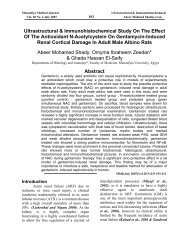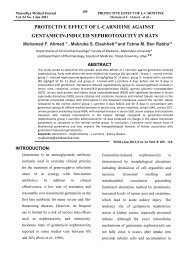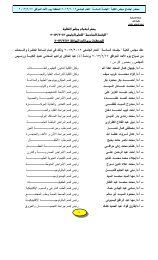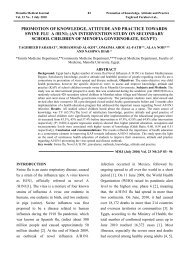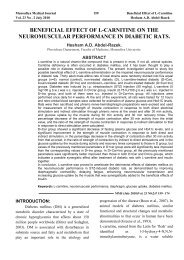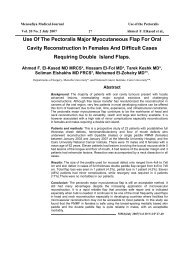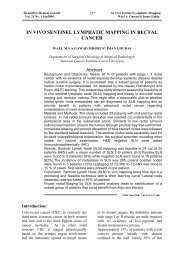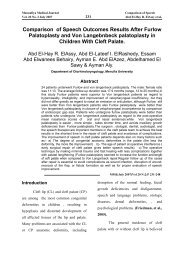Ahmed Azab *, Adel Hanafy *, Alaa Essa, Khaled Aref, Hesham ...
Ahmed Azab *, Adel Hanafy *, Alaa Essa, Khaled Aref, Hesham ...
Ahmed Azab *, Adel Hanafy *, Alaa Essa, Khaled Aref, Hesham ...
You also want an ePaper? Increase the reach of your titles
YUMPU automatically turns print PDFs into web optimized ePapers that Google loves.
Menoufiya Medical Journal 197 Surgical Aspects in Management<br />
Vol. 21 No . 2 July 2008 <strong>Ahmed</strong> <strong>Azab</strong> et al.,<br />
evaluating disc pathology, neural structures and<br />
muscloligamentous components and also gives<br />
excellent visualization of root anatomy, disc<br />
herniation and other conditions that may mimic it<br />
such as synovial cyst, neurofibroma or perineural<br />
cyst (11).<br />
All the patients were subjected to the posterior<br />
surgical approach as the most commonly used<br />
approach. Also because the patients of our study<br />
suffered not only isolated upper L.D.P but also,<br />
they were associated with lower lumbar canal<br />
abnormalities including the concomitant lower<br />
lumbar canal stenosis and lower lumbar disc<br />
prolapses, so the surgery was not directed only to<br />
the upper L.D.P, but also to the associated<br />
pathology, which are commonly treated with the<br />
posterior surgical approach. Intraoperatively, in<br />
18 cases constituting (60%), there was a soft disc<br />
bulge encroaching upon the nerve root exit<br />
foramine, while in 3 cases constituting (10%)<br />
there was a sequestrated disc prolpase with<br />
unilateral encroachment on the nerve root exit<br />
foramina. But in 9 cases constituting 30% of all<br />
cases in the present study, there was a hard<br />
spondylotic bar with a lateral recess stenosis and<br />
so, the surgical procedure done for this group<br />
was just a laminectomy and foraminotomy at the<br />
involved level without discectomy. While in 18<br />
cases constituting 60% of all cases in the present<br />
study were subjected to laminectomy (including<br />
formal and hemilaminectomy) unilateral<br />
facetectomy and discectomy at the involved<br />
level. Three cases with disc prolapses at D12-L1<br />
had an additional surgical procedures aiming to<br />
gain a lateral access to the disc prolapse with<br />
avoidance of manipulation to mobilize the<br />
sensitive neural structures at the upper lumbar<br />
levels including the conus medullaris and cauda<br />
equina. These additional surgical procedures<br />
included bilateral facetectomy with pedicle<br />
removal which necessitated an additional<br />
transpedicular fixation of one level above and<br />
one level below the involved level with<br />
instrumentation to avoid the late instability. So,<br />
the instrumental fusion was done for these<br />
patient depending only on one indication that<br />
was the extensive facetectomy to avoid the late<br />
instability.<br />
However, Scott P. Sanderson et al in 2004 in his<br />
retrospective study about patients with upper<br />
L.D.P, he mentioned that the fusion in patients<br />
with upper L.D.P treated surgically was done if<br />
the patient had incapacitating back pain, had<br />
preexisting spondylolisthesis or required such<br />
extensive facet removal to access the disc that<br />
predisposed the patient to instability (8).<br />
In addition, to the surgical intervention at the<br />
involved level, patients who suffered<br />
concomitant lower lumbar canal stenosis were<br />
subjected to decompressive laminectomy at<br />
lower lumbar levels, those patients were 18 cases<br />
constituting 60% of all cases of the present<br />
study. While patients who suffered concomitant<br />
disc herniation at lower lumbar level were 9<br />
cases: 5 cases of them were associated with disc<br />
prolapse at L4/5 level while 2 cases were<br />
associated with disc prolapse at L3/4 level and<br />
another two cases at L5/S1 level, and those<br />
patients were subjected to concomitant surgical<br />
intervention at the affected level in the form of<br />
laminectomy and discectomy in addition to<br />
surgical intervention at the upper lumbar disc<br />
prolapse.<br />
Regarding the postoperative sequelae of the<br />
patients operated in the present study, 24 patients<br />
(80%) showed complete relief of symptoms<br />
postoperatively, while 20% of patients showed<br />
partial relief of their complaints and those<br />
patients were found to have significant<br />
neurological deficits preoperatively mainly the<br />
motor weakness and sphincteric disturbances.<br />
Among this group of patients that showed partial<br />
relief of symptoms postoperatively, one patient<br />
was complicated with unintended durotomy<br />
intraoperatively and developed C.S.F. leak<br />
postoperatively which was managed in the ward<br />
conservatively till the leakage stopped and<br />
patient was discharged with relief of preoperative<br />
symptoms. Another patient developed<br />
postoperative spondylodiscitis and was treated<br />
with conservative measure and showed relief of<br />
preoperative symptoms after a period of one




